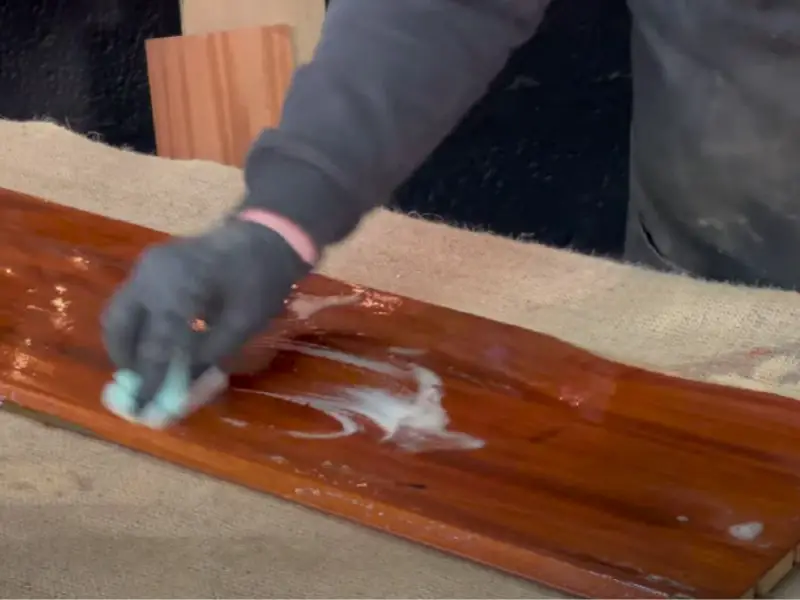How to Use Oxalic Acid to Bleach Wood
Stain marks on wood can be difficult to remove because you want to retain the natural color of the wood. While using various cleaning agents can get rid of stains, you want to ensure you do not lose the natural look of wood. But, can you use oxalic acid to bleach wood? How?
You can use oxalic acid to bleach wood and remove different stains, including iron stains. Mix and dissolve 12-16 oz of oxalic acid crystals in 1 gallon of hot water and apply to the stain using a brush. Allow it to dry then wash the area with a borax solution before wiping with a dark cloth.
Alternatively, you can use a ready-to-use wood bleach product such as Savogran 10501 concentrate to lighten wood surfaces, including wood paneling on walls.
Does oxalic acid bleach wood?

Oxalic acid is popular for people looking to bleach wood and remove dark water wood stains without extensive sanding. The acid restores wood after using iron-based products such as screws and nails.
Oxalic acid is an organic compound (HO2C−CO2H) that occurs naturally and is one of the simplest forms of dicarboxylic acids. The acid is common in foods such as spinach and sweet potatoes.
You can also produce high concentrations of oxalic acid through the oxidation of carbohydrates with nitric acid and vanadium pentoxide. People prefer using the chemical for cleaning and bleaching purposes because the acid is incredibly efficient in dissolving iron oxide stains without damaging the wood.
How to mix oxalic acid wood bleach
Oxalic acid often appears as a white crystalline powder. When using oxalic acid, you can prepare an acid wash solution or an acid paste to clean the stains from your wood. Acid wash solutions are ideal when dealing with large sections, while the paste is better suited to removing stains on specific spots instead of on the entire surface.
Preparing an acid wash solution
Prepare an acid wash solution when applying the acid over a large surface such as a hardwood floor or deck. You can accomplish the task without requiring professional assistance if you follow the correct procedure and observe recommended safety guidelines.
Here’s how you prepare an acid wash solution:
Pour oxalic acid powder into a clean mixing container and add hot water in a ratio of 1:6 (one part of the concentrated powder should dissolve in 6 parts of warm water). Stir thoroughly until the acid crystals dissolve in the water.
Hot water has a relatively higher rate of dissolution than cold water due to the kinetic energy of water molecules. You can adjust the concentration of your acid water solution depending on the intended task.
Prepare an acid paste
Oxalic acid paste appears as a thick, consistent white paste. You can use the oxalic acid paste to clean specific spots or remove iron stains from small sections of wood without necessarily dousing the entire surface in water. Preparing oxalic acid paste is relatively easy and ideal for removing wood stains in a DIY setting.
Here’s how to properly prepare an oxalic acid paste at home.
Pour a sizeable amount of oxalic acid powder into a mixing container and add a small amount of warm water. Mix thoroughly to form a white, consistent paste. An ideal mixing ratio for your acid paste is 1:3 (one part powder for three parts warm water).
You can also adjust your paste’s consistency to your required thickness by adding small quantities of water periodically as you mix.
Bleaching wood is a delicate process that requires expertise and care. It’s crucial to stick to proper mixing ratios for the best results and to avoid causing additional problems to your wood. Besides, the powdered oxalic acid substrate has a high pH that can cause skin discomfort and irritation when exposed to sensitive parts of your body.
It’s advisable to ensure that you wear protective clothing, including gloves and eye googles during preparation.
How to bleach wood using oxalic acid
Oxalic acid is an excellent choice for bleaching wood and removing wood stains without causing adverse effects on the quality of your product. The chemical offers an organic alternative to popular bleaching products and has a variety of alternative uses within your house.
Here are some steps to consider when using oxalic acid to bleach wood
1. Remove dust from the wood surface
Ensure that your surface is clean before using oxalic acid wood bleach. Sand the wood and wipe the wood dust using a dry cloth.
Alternatively, you can use a wood cleaner to remove paint, varnish, and other finishes from your timber before attempting to use the chemical on your timber.
Give your wood enough time to dry.
2. Mix the oxalic acid with hot water to create a paste
Prepare an acid wash solution/oxalic acid paste by mixing the oxalic acid powder with hot water in the recommended ratio (1:6 for the solution or 1:3 for the acid paste). It’s better to prepare moderate quantities at a time and prepare more of the solution/paste as you progress.
3. Apply the paste to the wood
Use a paintbrush or scraper to apply the diluted solution to the wood surface evenly. Leave it for about an hour. You can opt to use a mop when bleaching a large area such as a wood floor surface. Ensure that you cover the entire surface for an even finish, especially if using an acid wash solution.
The bleaching effect is faster on softwoods and might take up to 20 minutes for the stain to disappear. Usually, hardwood floors are harder to clean, and the stain might take an hour to disappear completely.
You can repeat the process two or three times if your find stain remnants on your wood, but give the wood bleach enough time for it to work. When using an acid paste, scrape off the paste only after drying.
4. Neutralize the acid with a borax solution
Ensure you neutralize the acid before applying a finish to your wood. Oxalic acid can affect the quality of your finish. Using an effective alkaline solution can help you avoid inconsistencies in your finish.
You can use a mixture of water and borax to help neutralize the acid’s effects. A baking soda solution is also effective. Baking soda is readily available and has similar anti-acid properties to borax.
Mix two teaspoons of borax with one quart (0.25 gallons) of water to create a dilute solution and apply it to the affected surface. Give it a few minutes to allow the chemical to work effectively. Rinse thoroughly and allow your wood to dry.
5. Sand the wood and apply a finish
It’s advisable to sand your wood before applying a finish. You can also use the time to check for any stain remnants and correct any inconsistencies before applying your finish.
How long should you leave oxalic acid on wood?
Leave the oxalic acid solution on wood for at least 4 hours for it to bleach and lighten the wood effectively. However, you can leave it for longer depending on the severity of the stain and the concentration of the acid solution. Monitor the affected patch every 2 hours to check on its state.
Alternative ways to bleach wood
Oxalic acid is an ideal method for bleaching wood. However, you can use other alternatives to remove stains from your timber surface. Alternative wood bleaching methods can yield mixed results and significantly affect the quality of your wood.
Use these practical alternatives to bleach wood:
Household bleach
Household bleach is a viable alternative for lightening wood and removing stains from its surface.
Mix household bleach with water in a ratio of 1:1 and apply the solution to the desired surface. However, it is crucial to ensure that the wood type handles bleach well.
Some wood varieties such as pine, poplar, redwood, cedar, and rosewood may suffer a loss of wood quality after bleaching.
Other ways you can bleach wood include:
- Using a mixture of ammonia water and hydrogen peroxide.
- Using citric acid as a bleaching agent.
- Using white vinegar as a bleaching agent.
- Use a commercial wood bleach such as Zinsser 300451
CONCLUSION
Oxalic acid is a great bleaching agent for wood surfaces. It removes stains and lightens dark marks on wood, which is why it is used on decks, wood floors, furniture, and wood paneling to restore the natural look of timber.
MORE ABOUT WOOD
- Can You Use Vinegar on Wood?
- How to Stop Ghosting (Footprints) on Hardwood Floors
- How to Remove Sticky Residue from Wood
- Does Hackberry Make Good Firewood?
References
